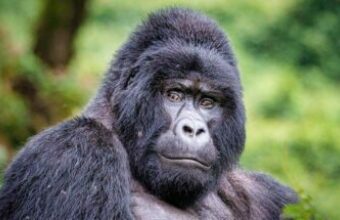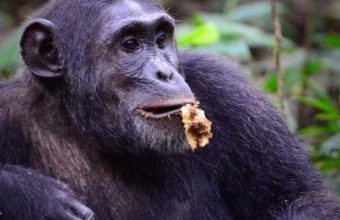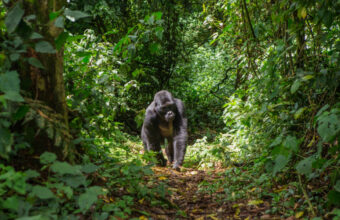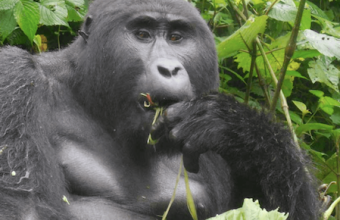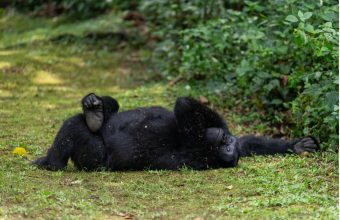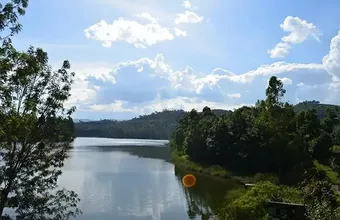Conservation & Responsible Gorilla Trekking
Gorilla families vary in size from fewer than 10 members to 65, with bigger families usually splitting into smaller groups.
Mountain gorillas are social animals. A typical family consists of one silverback, several adult females and their offspring; it’s also common for families to include closely-related adult males. When a family leader dies, a subordinate either takes over or the remaining individuals join another family.
There are more females than males in a gorilla family, so a small number of male loners roam the forests by themselves, occasionally banding together into all-male groups.
Female mountain gorillas start giving birth at around ten years old and give birth once every four years or so. Roughly a quarter of their offspring die in their first year. If a mother and baby move to a different family, it’s common for the baby to be killed by the new silverback.
Just like humans, every gorilla has a unique character, and each family has their own traits and personalities. The ranger guides know each individual and are happy to share tales about their characters, interactions and squabbles.
In the dense rainforest, sound is a more useful method of communication than sight. Baby gorillas vocalise through crying, whimpering and screaming. Adults, particularly males, communicate through grunts, barks, cries and chest drumming. Facial expressions are also incredibly important.
Threats and conservation
In a 1981 census, just 254 mountain gorillas were recorded in the wild. These were bleak days for the species, with untrammelled poaching for bushmeat and the exotic pet trade pushing mountain gorillas to the brink of extinction.
Their plight was brought to the world’s attention thanks to the efforts of zoologists like Dian Fossey and broadcaster Sir David Attenborough. Fossey dedicated her life to studying the mountain gorilla, spending decades living among what were then classed as critically endangered apes in Rwanda and the DRC.
During those dark days of the 1970s and 80s Fossey explained the scale of the challenge: “Active conservation [of the gorillas] involves simply going out into the forest, on foot, day after day after day, attempting to capture poachers, killing—regretfully—their dogs, which spread rabies within the park, and cutting down traps.”
Almost 40 years on, although populations are gradually recovering, the species is still classified as endangered. Here’s why.
Habitat loss
The biggest threat to the mountain gorilla comes from habitat loss. As human populations grow, they encroach into the gorilla’s habitat. Commercial forest logging, road building and the conversion of land for agricultural purposes all endanger the gorilla habitat. The scarcity of paid employment and limited natural resources of communities living near the mountain gorillas means that they often see the gorillas as competitors rather than as a source of income.
Disease
Gorillas share 96% of our DNA, with similar physiological features. They are highly susceptible to human diseases but do not share our immunity. Consequently, exposure to human viruses or illnesses can devastate entire gorilla populations. Some gorilla families have already been damaged by exposure to skin conditions like scabies and respiratory diseases are particularly contagious.
Poaching
Poaching of mountain gorillas is still a threat to their survival, despite being greatly reduced over recent decades. Poaching occurs for three main reasons: through ‘unselective’ hunting (where hunters aim to catch other animals but injure gorillas), for live animal trade, and to be sold as bushmeat. Gorillas are also poached for use in traditional medicine, with trophies used as charms or as ingredients.
The Covid-19 pandemic put mountain gorillas back at the forefront of the region’s conservation agenda: in June 2020, Rafiki a well-loved Ugandan silverback gorilla was killed by a poacher, who was later jailed. The massive reduction in tourism revenue and the lack of surveillance put Africa’s wildlife in a precarious position once more.
Conservation efforts
Today the mountain gorilla is a huge conservation priority in both Rwanda and Uganda, in part thanks to the lucrative gorilla tourism industry.
The success of mountain gorilla conservation has improved the species’ status from critically endangered to endangered, according to the Red List of Threatened Species published by IUCN (International Union for Conservation of Nature and Natural Resources).
Conservation efforts include improved policing of protected areas, harsher penalties for poachers and traffickers, better veterinary care, community education, the development of alternatives to firewood for fuel, and investments in new types of livelihood.
Local communities and tourism
One of the key factors for effective conservation is an awareness of the people who also depend on the land for their own survival. Much of the gorilla habitat borders and overlaps with remote and poor communities. People lived in these areas long before national parks and protected areas were created, and hunters and farmers have always used the forest as an essential source of fuel and food. They now find the entrance to their historical lands is strictly controlled and regulated.
To mitigate the human impact, a percentage of every gorilla permit fee (10% in Rwanda, 20% in Uganda) is invested in the surrounding communities to support infrastructure, schools and alternative livelihoods to poaching.
Despite considerable hurdles, the conservation through tourism model has been largely successful and revenues from the sale of gorilla tracking permits have made a huge impact on their long-term outlook. That said, the devastating impact of the COVID-19 pandemic requires a rethink of balanced and sustainable sources of funding.
Gorilla trekking has become the number one tourist activity in both Rwanda and Uganda and the industry is highly developed and professionally organised. In choosing to visit the mountain gorillas you can contribute directly to the species’ survival, provided that you’re a responsible traveller and play by the rules.
The dark side of conservation
Conservation isn’t always inclusive. In the 1990s the mountain gorilla seemed to face certain extinction and international pressure for action mounted. Bwindi and Mgahinga National Parks were established but with little consideration for the Batwa, indigenous tribes people who had lived in the forest alongside the mountain gorillas for millennia.
Suddenly this tiny community of a few thousand found their entire way of life outlawed; they were branded as common poachers and evicted from their ancestral lands. The displaced Batwa were left landless and destitute, dependent on charity and government support for their survival. Support for the Batwa is now more readily available, but sadly the damage to this ancient forest tribe has already been done.

